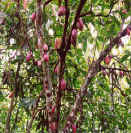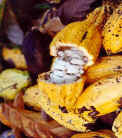Chocolate
Information, Origin and History of Chocolate plus
Large Chocolate Recipe Collection
�
�
�
See Also:����Tempering
Chocolate
|�
Chocolate Ganache�
|��
National Chocolate Week� |�
Chocolate
Recipes
�
 The
common cacao tree is classified as Theobroma cacao and belongs to the
family Sterculiaceae. They are very delicate and need much protection in their
first four years of growth. With careful cultivation, the trees of most strains
will begin bearing fruit in the fifth year. The fruit containing the seeds are
about the size of a small pineapple when harvested. The
common cacao tree is classified as Theobroma cacao and belongs to the
family Sterculiaceae. They are very delicate and need much protection in their
first four years of growth. With careful cultivation, the trees of most strains
will begin bearing fruit in the fifth year. The fruit containing the seeds are
about the size of a small pineapple when harvested.
���������������������
�
�
How chocolate is made
 The processing of the cacao seeds (cocoa beans) is not a simple task.
Firstly the fruit is fermented which takes 3 to 9 days,
during which the heat dries the seeds and turns them brown. The beans are then
dried in the sun and cleaned in special machines before they are roasted.
This loosens the outer shell which separates the shell from its center or
"nib" which is further processed into Chocolate
Liquor,�
by grinding it to
a smooth, liquid state. Further processing takes place for the various types of
�eating� chocolate as follows:- The processing of the cacao seeds (cocoa beans) is not a simple task.
Firstly the fruit is fermented which takes 3 to 9 days,
during which the heat dries the seeds and turns them brown. The beans are then
dried in the sun and cleaned in special machines before they are roasted.
This loosens the outer shell which separates the shell from its center or
"nib" which is further processed into Chocolate
Liquor,�
by grinding it to
a smooth, liquid state. Further processing takes place for the various types of
�eating� chocolate as follows:-
�

Dark
Chocolate
�is
chocolate liquor with additional sweeteners and cocoa butter.
�
Milk
Chocolate�
is chocolate liquor with additional cocoa butter, milk, sweeteners and flavorings.
�
White
Chocolate
has no formal definition. White chocolate contains sugar, cocoa butter, milk
solids and flavorings such as vanilla but does not contain non-fat cocoa solids,�
so is mostly used as a
coating.
�
Couverture is a term describing professional-quality
coating chocolate that is extremely glossy. It usually contains a minimum of 32%
cocoa butter, which enables it to form a much thinner shell than ordinary
confectionary coating.
�
Ganache
is
a thick, extremely rich chocolate spread. It is made by pouring hot cream over
chopped up chocolate and whipping the mixture until the chocolate melts and the
mixture becomes thick and stiff. See
Chocolate Ganache.
Cocoa contains as much as 20% protein, 40%
carbohydrate, and 40% fat. It is also mildly stimulating because of the presence
of Theobromine, an alkaloid� closely related to caffeine.
�
A Brief
History of Chocolate
1502 - Christopher Columbus introduces chocolate to Spain from his fourth
voyage to the New World in 1502 but not as the product we know today. It was
only consumed as a drink. The word "chocolate" was derived from the
Aztec word xocolatl which means bitter water.
1615 � Anne of Austria (wife of Louis XIII) declares chocolate as the
drink of the French Court , although this was only after much skepticism, as
initially it was considered a "barbarous product and noxious drug".
1640 � chocolate finds its way to England, among other European
countries.
|



